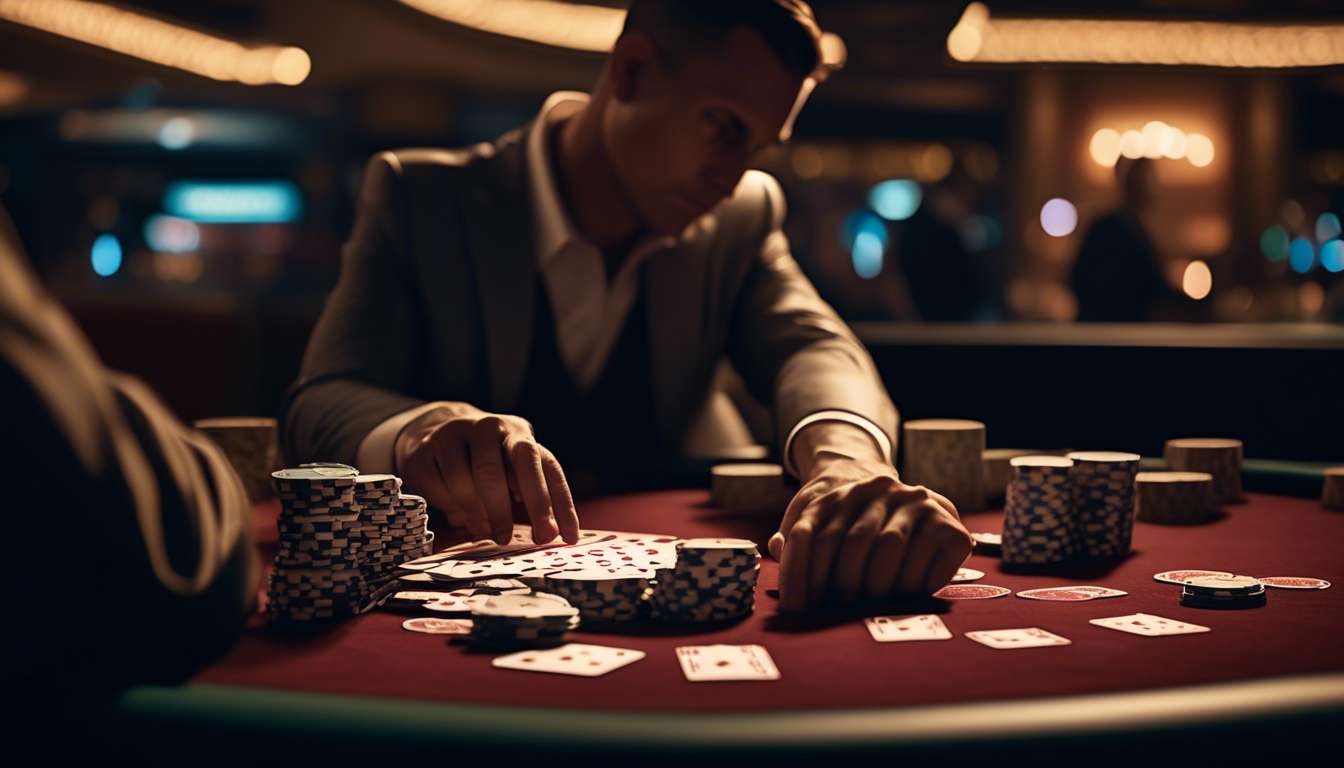In the world of poker, every card dealt and every chip placed carries significant weight. We are drawn to the intricate dance of strategy and intuition that defines the game.
As enthusiasts of this timeless card game, we recognize that mastering poker is not just about the cards in our hands. It’s about deciphering subtle signals and cues from our opponents. The art of reading opponents transforms the game from mere chance into a sophisticated mind sport.
Together, we embark on a journey to explore the psychological nuances and tactical maneuvers that give seasoned players their edge. By delving into strategies that reveal what lies beneath the poker face, we aim to equip ourselves with the tools necessary to outsmart even the most skilled adversaries.
Join us as we unravel the complexities of human behavior at the poker table, enhancing our game with every tell we uncover.
Understanding Non-Verbal Cues
Mastering the art of reading non-verbal cues gives us a significant edge in understanding our poker opponents’ intentions and emotions. Decoding subtle signals that betray a player’s true hand goes beyond just noticing a twitch or a nervous glance. It’s about sensing the energy at the table and connecting with the ebb and flow of the game. When we hone this skill, we become part of an exclusive group that thrives on the nuances others might miss.
Non-verbal cues are our roadmap to bluff detection. Observing various behaviors can reveal if an opponent is bluffing. These include:
- How opponents hold their cards
- The way they stack their chips
- Their breathing patterns
These silent whispers often speak louder than words, providing the clues we need to anticipate our opponents’ next moves.
By combining these insights with an understanding of betting patterns, we strengthen our position and enhance our ability to read the game. Let’s embrace these shared skills and grow stronger together.
Analyzing Betting Patterns
We can gain valuable insights into our opponents’ strategies by closely examining their betting patterns throughout the game.
Together, as a community of poker enthusiasts, we recognize that each bet tells a story. When we notice consistent behavior, such as aggressive betting or sudden changes in bet size, we can start piecing together their strategy. This shared understanding deepens our connection and enhances our collective skills at the table.
Betting patterns often act as a reliable indicator of hand strength.
We should be on the lookout for non-verbal cues accompanying these patterns, such as a player hesitating before making a large bet. These signs can be crucial in bluff detection.
- When we spot inconsistencies, like a player suddenly making a substantial bet with little hesitation, it might indicate a bluff attempt.
By analyzing these patterns, we not only improve our game but also cultivate a sense of camaraderie, learning from each other’s experiences and honing our poker instincts.
Deciphering Timing Tells
Timing Tells in Poker
By paying close attention to the time each player takes to make their decision, we can uncover valuable insights into their thought processes and hand strength. Timing tells, one of the most subtle non-verbal cues, offer us a window into whether an opponent is confident or unsure.
- When someone bets quickly, they might be holding a strong hand or trying to bluff us into thinking they are.
- A hesitant, prolonged decision can indicate doubt, weakness, or a complex hand.
Enhancing Bluff Detection with Timing Analysis
Incorporating timing analysis with betting patterns enhances our bluff detection capabilities. If a player usually acts quickly but suddenly hesitates, it could indicate a significant change in their hand or strategy.
Together, we can develop a keen sense of timing tells to add another layer to our poker intuition.
Conclusion
Let’s remember, it’s not just about the cards—it’s about understanding the rhythm of the game and reading the unspoken signals that bind us all at the table.
Spotting Verbal Indicators
Listening carefully to our opponents’ words and tone can reveal a wealth of information about their confidence and potential hand strength.
When players engage in table talk, subtle shifts in their voice or word choice might signal strength or weakness. We’ve all been at the table when someone suddenly becomes chatty, often a sign they’re trying to distract from their bluff. Conversely, a quiet, reserved tone might indicate a solid hand.
Let’s combine these verbal indicators with Non-Verbal Cues and Betting Patterns to sharpen our Bluff Detection skills.
- If a player’s confident words don’t match their hesitant betting or nervous gestures, it’s time to question their sincerity.
In our poker community, recognizing these mismatches strengthens our connections and enhances our game.
By actively listening and observing, we foster a deeper understanding of the dynamics at play.
Together, we can use these insights to make more informed decisions, ultimately enhancing our shared pursuit of poker mastery.
Exploiting Emotional Reactions
Understanding our opponents’ emotional reactions can give us a significant edge at the poker table. As a community of players, we thrive on the shared experience of outsmarting opponents.
Non-verbal cues are crucial in deciphering the subtle signals that betray true emotions. An opponent’s:
- Posture
- Facial expressions
- Hand movements
often reveal more than their words ever could.
In our quest for mastery, we also examine betting patterns:
- A sudden increase in bets might indicate excitement or overconfidence.
- A hesitant bet could suggest uncertainty or fear.
We recognize these patterns as opportunities to exploit their emotional state.
Bluff detection is another valuable skill in our toolkit. By combining non-verbal cues with betting patterns, we can often sense when an opponent is trying to deceive us.
This ability to see through bluffs not only enhances our gameplay but also strengthens the bond among players who share these insights. Together, we become a formidable force at the table.
Adapting to Different Player Types
To effectively adapt to different player types, we must first identify their unique playing styles and tendencies.
Observing Non-Verbal Cues:
- Look for signs of confidence or hesitation.
- Are they fidgeting, or are they calm and composed?
- Such signals can reveal a lot about their hand strength and strategies.
Betting Patterns:
- Pay close attention to how they bet.
- Does a player consistently raise pre-flop or suddenly bet aggressively?
- Recognizing these patterns helps us anticipate their moves and adjust our strategies accordingly.
Bluff Detection:
- Analyze past behavior to understand their bluffing frequency.
- Combine this analysis with cues and betting habits.
- Better judge when they’re bluffing to make informed decisions.
Remember, poker is a community where we all aim to outsmart each other. By understanding and adapting to various player types, we enhance our sense of belonging and camaraderie at the table, making the game more enjoyable and rewarding for everyone.
Utilizing Table Image to Advantage
Our table image can significantly influence how opponents perceive and react to our moves.
At the poker table, creating a strong, consistent image helps us control the narrative. When we project confidence through non-verbal cues, such as:
- Maintaining eye contact
- Steady posture
We can signal strength. Conversely, occasional hesitations might suggest vulnerability, keeping opponents guessing.
Betting Patterns
By carefully crafting our betting patterns, we can reinforce our image. For instance:
- Aggressive bets might convince others we have a strong hand, even when we don’t.
Through deliberate consistency, we make it harder for others to predict our intentions, which is crucial to maintaining an edge.
Mindful Presentation
In our poker community, we’re aware that every player is trying to read us just as we’re reading them. By being mindful of how we present ourselves, we can turn the table image to our advantage. This makes our bluffs more believable and allows us to capitalize on others’ misreads without relying solely on bluff detection skills.
Mastering Bluff Detection
Detecting bluffs at the poker table requires a keen eye and an understanding of subtle behavioral clues. It’s not just about the cards in play; it’s about reading the room and connecting with the unspoken language of poker.
Non-Verbal Cues:
- A change in breathing
- A quick glance
- A shift in posture
These non-verbal cues are crucial in spotting a bluff. Let’s pay attention to these signals and share our observations as a united table.
Betting Patterns:
- Notice irregularities in opponents’ bets.
- Watch for sudden, aggressive bets that might be attempts to scare us off a strong hand.
By analyzing these patterns, we become more than just players; we’re a team, decoding the game together and strengthening our collective intuition in the art of poker.
Conclusion
In conclusion, mastering the art of poker involves keen observation and strategic thinking. By honing your skills in reading opponents, you can elevate your game to new heights.
Key areas to focus on include:
- Non-verbal cues
- Betting patterns
- Timing tells
- Verbal indicators
- Emotional reactions
- Player types
- Table image
- Bluff detection
Remember, poker is not just about the cards you hold, but about the ability to outwit and outplay your opponents at every turn.
Keep practicing and refining your skills to become a formidable force at the poker table.




